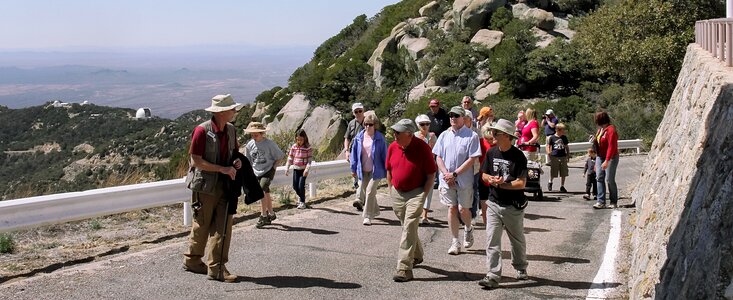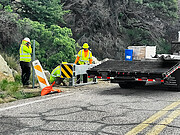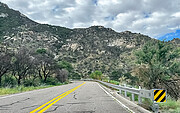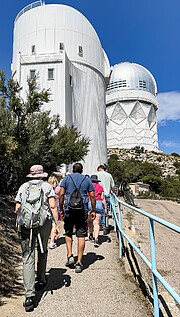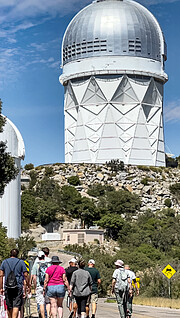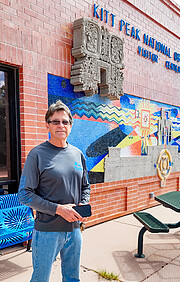Kitt Peak National Observatory Hosts Soft Reopening
21 September 2023
Kitt Peak National Observatory will begin a limited reopening program to welcome the public through its doors and domes starting Friday 22 September. Following a more than three-year closure as a result of the COVID-19 pandemic and the Contreras Fire, the historic KPNO will finally welcome visitors back to enjoy its guided daytime tours and nighttime observing programs.
Beginning on 22 September, Kitt Peak National Observatory (KPNO), a Program of NSF’s NOIRLab, will restart guided daytime tours for public visitors on Fridays, Saturdays to Sundays through the Kitt Peak visitor center [1]. Safety considerations following the Contreras Fire and limited parking availability mean that access to the observatory will only be possible through advance tour reservations. Visitors are encouraged to reserve tour seats well in advance as there are only 60 tour slots available per day: anyone wishing to tour Kitt Peak’s campus will need a reservation.
During the tours, visitors can explore KPNO’s rich assortment of telescopes — the largest and most diverse collection in the world — and their respective histories and discoveries. Among the tour highlights is a visit to the Nicholas U. Mayall 4-meter Telescope, home of the record-breaking DESI (Dark Energy Spectroscopic Instrument) survey. The DESI project, managed by the US Department of Energy, aims to study the mysterious dark energy by creating a 3D map of over 40 million galaxies. A second tour visits the KPNO 2.1-Meter Telescope which was one of the earliest Kitt Peak telescopes and is used for both imaging and spectroscopy.
In addition to resuming its daytime tours, KPNO has restarted its Overnight Telescope Observing Program. Through this custom program, anyone can live like an astronomer for a full night. Visitors get all-night access to a telescope which they can use for visual observing (looking at an object directly through an eyepiece) or capturing images of deep-sky objects. Tickets for this one-of-a-kind experience are available on Eventbrite. Evening programs, including the Nightly Observing Program and the Dark Sky Discovery Program, are expected to return in October. Please subscribe to our Eventbrite listing to be notified when we publish new events.
Kitt Peak will be closed to visitors from Monday to Thursday until the end of September. Visitors can expect more open days in October.
While self-guided tours of the observatory grounds are not possible at the moment, SR 386 is a public roadway and bicyclists and motorists who want to enjoy the challenging and beautiful route up the mountain are welcome without reservations. Parts of the mountain, including the picnic area, are still inaccessible because of damage from the fire. While the Visitor Center is open to purchase local hand-crafted gifts, no food or drinks are available for purchase on the mountain — please bring your own. Bathroom facilities are available near the Visitor Center parking lot.
KPNO and NOIRLab are grateful for the efforts of the Arizona Department of Transportation (ADOT) in repairing the fire damage sustained along State Road 386, the access road to the observatory. The road has been repaired and equipped with new, safer guardrails. The road also had embankment curb repairs made as well as roadway patching, culvert repair and re-striping.
“We really appreciate the hard work by ADOT to effect these important repairs; the public can once again experience the wonders of the Universe atop Kitt Peak,” said Associate Director of KPNO Michelle Edwards.
More information
[1] The Kitt Peak visitor center opened its doors in 1964 and will celebrate its 60th anniversary in 2024.
NSF’s NOIRLab (National Optical-Infrared Astronomy Research Laboratory), the US center for ground-based optical-infrared astronomy, operates the International Gemini Observatory (a facility of NSF, NRC–Canada, ANID–Chile, MCTIC–Brazil, MINCyT–Argentina, and KASI–Republic of Korea), Kitt Peak National Observatory (KPNO), Cerro Tololo Inter-American Observatory (CTIO), the Community Science and Data Center (CSDC), and Vera C. Rubin Observatory (operated in cooperation with the Department of Energy’s SLAC National Accelerator Laboratory). It is managed by the Association of Universities for Research in Astronomy (AURA) under a cooperative agreement with NSF and is headquartered in Tucson, Arizona. The astronomical community is honored to have the opportunity to conduct astronomical research on Iolkam Du’ag (Kitt Peak) in Arizona, on Maunakea in Hawai‘i, and on Cerro Tololo and Cerro Pachón in Chile. We recognize and acknowledge the very significant cultural role and reverence that these sites have to the Tohono O’odham Nation, to the Native Hawaiian community, and to the local communities in Chile, respectively.
Links
Contacts
Michelle Edwards
Associate Director of Kitt Peak National Observatory
Email: michelle.edwards@noirlab.edu
Garin Groff
ADOT Public Information Officer
Email: ggroff@azdot.gov
Josie Fenske
NSF’s NOIRLab Communications
Email: josie.fenske@noirlab.edu
Lars Lindberg Christensen
Head of Communications, Education & Engagement
Tucson, United States
Email: lars.christensen@noirlab.edu

